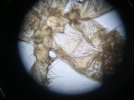-
Are you a Tarantula hobbyist? If so, we invite you to join our community! Once you join you'll be able to post messages, upload pictures of your pets and enclosures and chat with other Tarantula enthusiasts. Sign up today!
You are using an out of date browser. It may not display this or other websites correctly.
You should upgrade or use an alternative browser.
You should upgrade or use an alternative browser.
Question about sexing—
- Thread starter Poppy2020
- Start date
Tarantulafeets
Well-Known Member
- Messages
- 348
- Location
- Socal
I'd assume that they would still be there, just not as developed as when they are bigger. I've seen a few pics of spermathaca on really small slings, but the molt would be really hard to manipulate.
- Messages
- 6,382
- Location
- The Oregon rain forest
@sdsnybny uses a microscope and sexs spiders at a very young age. As long as the molt isnt damaged.
rapidfire
Well-Known Member
- Messages
- 207
- Location
- Washington State
Ive sexed 1” slings with my microscope. I find the smaller ones are hard to get the molt spread out without butchering it.
ProfessorChani
New Member
- Messages
- 6
- Location
- Ironwood, MI
I use a microscope as well and would agree with what everyone says here. For reference, I have attached one image of very clear spermethecae on my A. seemani almost 2-inch molt (even without having the molt spread perfectly), and a much harder to see tiny speck indicating potential spermathecae on my H. villosella less than 1-inch molt. For the smaller molts, I tend to keep my sex determinations tentative, but at least I feel like I have an idea, depending on if I could keep the molt specimens intact!
Attachments
Quentink35
New Member
- Messages
- 4
- Location
- Colorado USA
Yes. The smaller the t the harder it is to tell. Whrn theyre mayure you dont even need a microscope just look for a slot above the booklungs and if u see a slot(for mate enterance) you have a female. Another way to tell is when your male is ready to mate, embolis will come out of his from two pedipalps and hell use this to build a sperm web and deposit his sperm in. So if u see ur tsrantula building a web with visible hooks on his front pedipalps(Male fahsho) females are also bigger than males so look up the male a female average max size and that could help. But with a great microscope( i wouldnt try to sex a sling)you can have a juvenile and take the molt, open up the abdomen and look for the sperm pocketDoes a tarantula need to be a certain age before telling gender is present under a microscope?
Thank you!
i haven’t logged in in a while…@Theneil uses a microscope if I recall. Perhaps he may be able to give you some insight on the topic.
Yes. i bought a digital microscope off amazon with a built in screen. (cost about 100 bucks at the time of purchase) While there is biologically no minimum age/size that i’m aware of, fine motot skills, identification skills, and the quality of equiptment start to become major factors when you start getting into very small/young specimens. i find for most ‘average’ size species, sexing ith my microscope is usually reasonably possible at about 1.5” though not at all quick and easy most of the time, and 2-2.5” is usually where it becomes very quick and easy for me to unravel and identify what is necessary for sexing. under 1.5” and the view quality can become a limiting factor as the organs are both tiny and transparent, they can be easilly overlooked even with top notch equipment, and with budget grade (like mine) can become lost in the resolution, especially if the light doesn’t it it just right, and/or you poke around to move things.
With smaller species (like cyriocosmus elegans) where the spermathecae are more developed in a 1/2” spider, it’s easy to identify, and usually the limiting factor is not seeing, but simply being able to unravel the molt before accidentally destroying it. personally, i don’t thinknimve seced anything smaller than 1/2” legspan, and usually i’m not willing to even take the time to attempt it…
i’ll attatch a photo (camera pic of my microscope screen) to show the molt of a female Avicularia merianae. I think this little lady was a little under 1.5” DLS, but i don’t remember for certain. It does show though how easy it is to miss, and if you go smaller, it get’s exponentially easier to overlook.

